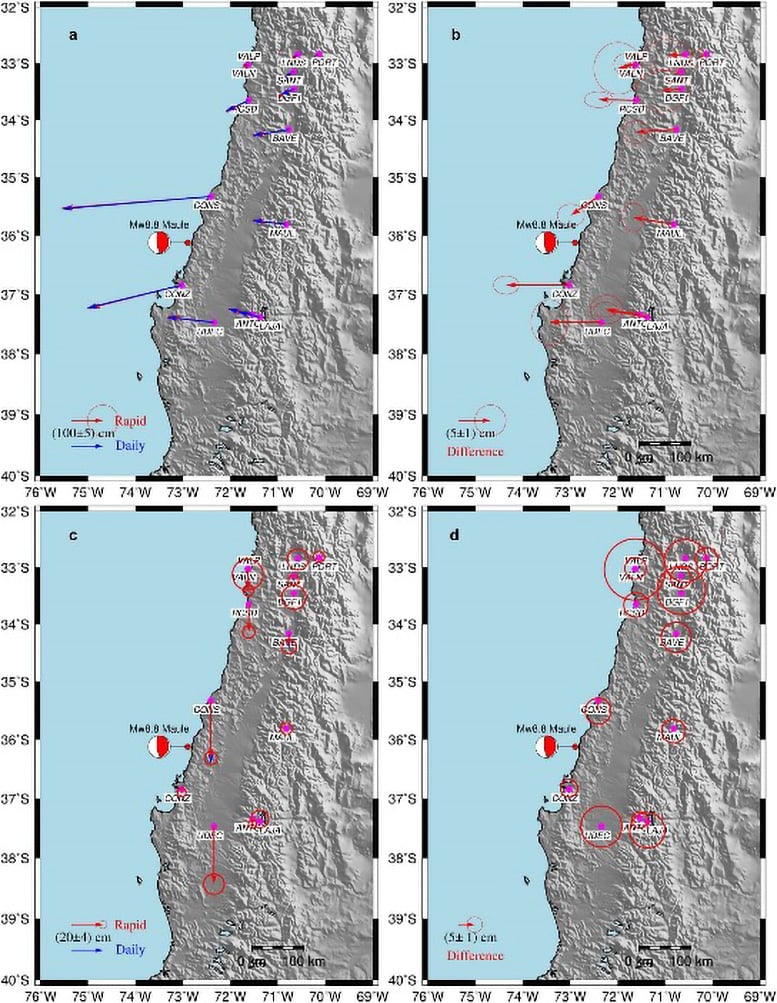
A groundbreaking study using sub-daily GPS has improved our understanding of early afterslip following earthquakes, offering a more accurate assessment of seismic hazards and enhancing emergency response and preparedness strategies.
A groundbreaking study has revealed new insights into the Earth’s crust’s immediate behavior following earthquakes. Researchers have utilized sub-daily Global Positioning System (GPS) solutions to accurately measure the spatial and temporal evolution of early afterslip following the 2010 Mw 8.8 Maule earthquake. This innovative approach marks a significant advancement in seismic analysis, offering a more precise and rapid depiction of ground deformations, which is essential for assessing seismic hazards and understanding fault line activities.
The aftermath of an earthquake is marked by intricate postseismic adjustments, particularly the elusive early afterslip. Daily seismic monitoring has struggled to capture the rapid and complex ground movements occurring in the critical hours post-quake. The intricacies of these initial activities and their profound implications for seismic hazard assessment highlight an urgent need for more refined and immediate monitoring techniques.

Innovations in Seismic Data Analysis
Wuhan University researchers, in a paper published on July 29, 2024, in Satellite Navigation, unveil their meticulous examination of the Maule earthquake’s early afterslip. Utilizing sub-daily GPS solutions, the study delivers a comprehensive narrative of the ground surface deformations occurring in the pivotal hours following the earthquake.
This study employs sub-daily GPS data to provide a high-resolution depiction of the 2010 Mw 8.8 Maule earthquake’s postseismic afterslip. The innovative approach captures the rapid ground deformations that typically elude daily GPS measurements, revealing a nearly 10% reduction in the overestimation of coseismic displacements. The research illustrates the predominance of afterslip in the first 36 hours, overshadowing poroelastic effects, and contributes significantly to seismic hazard assessment. The findings enhance the clarity and depth of our understanding of the Earth’s postseismic dynamics, offering a robust tool for improving early warning systems and disaster response strategies.
Dr. Yangmao Wen, the study’s corresponding author, highlights its significance, noting, “Our research demonstrates the sub-daily GPS’s adeptness at capturing the intricate dynamics of early afterslip, which is crucial for evaluating seismic risks and deciphering fault behavior post-earthquakes.”
The deployment of sub-daily GPS in seismic studies heralds a new era in hazard management. It enables a more accurate and expedited assessment of postseismic activities, allowing for more effective responses to earthquake impacts. The enhanced accuracy in early afterslip measurements is set to improve aftershock predictions, optimize emergency preparedness, and mitigate the seismic vulnerability of at-risk communities. This advancement in geodetic monitoring is a step change toward a more profound comprehension of earthquake dynamics and their societal implications.
Reference: “Rapid early afterslip characteristics of the 2010 moment magnitude (Mw) 8.8 Maule earthquake determined with sub-daily GPS solutions” by Kai Liu, Yangmao Wen, Jing Zeng, Jianghui Geng, Zhao Li and Caijun Xu, 29 July 2024, Satellite Navigation.
DOI: 10.1186/s43020-024-00145-6
This work is funded by the National Natural Science Foundation of China (42025401 and 42374003), and the Hubei Luojia Laboratory (No. 220100021).